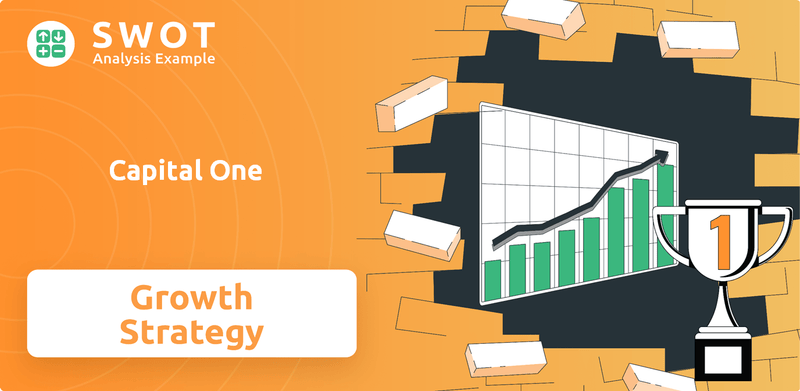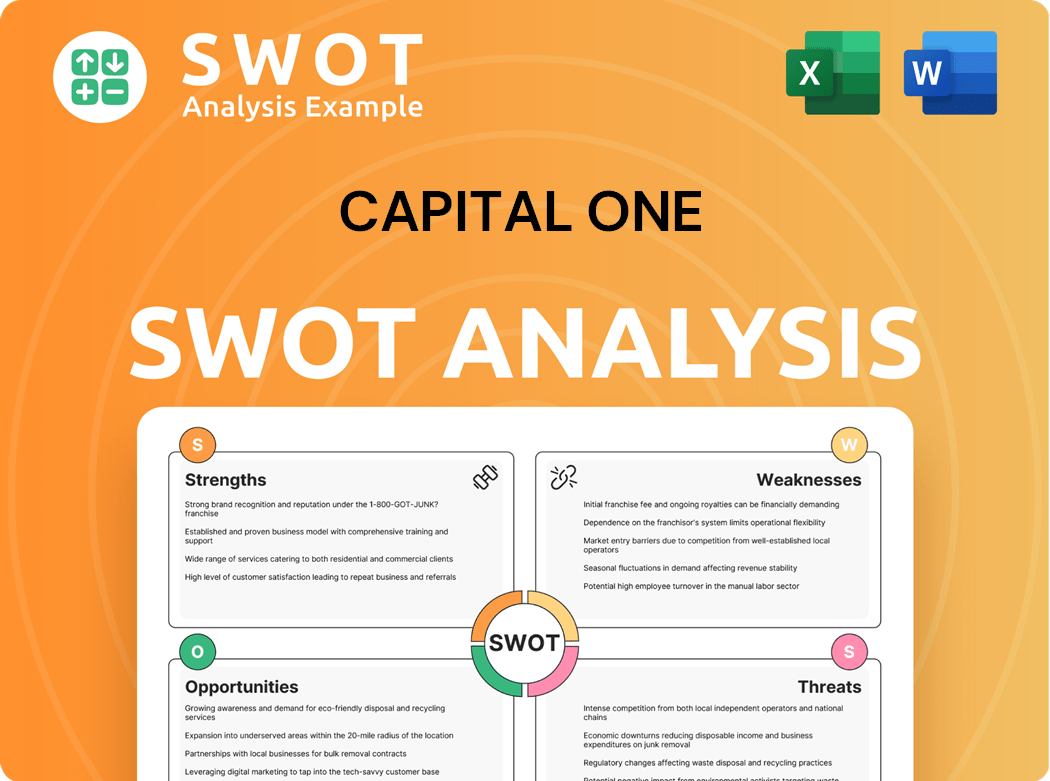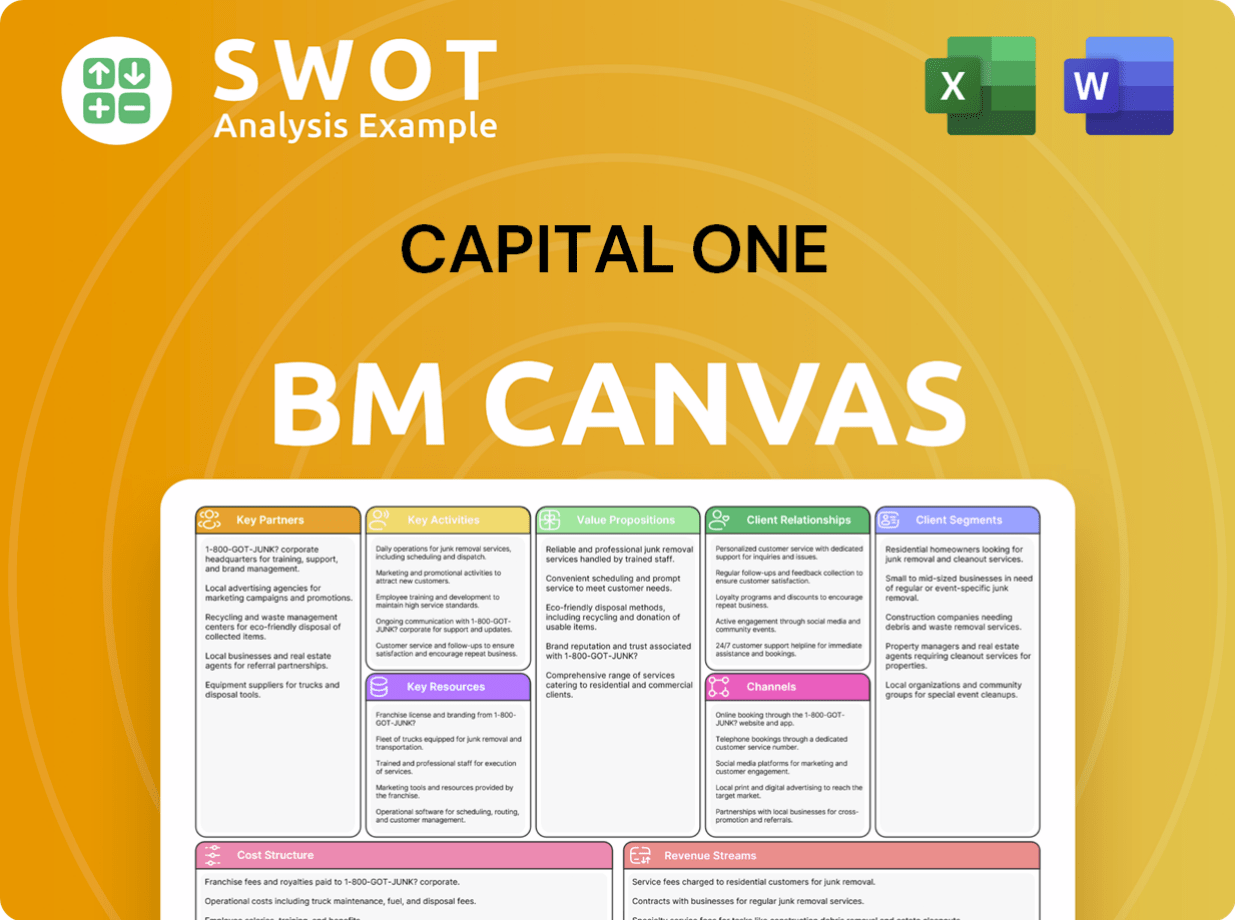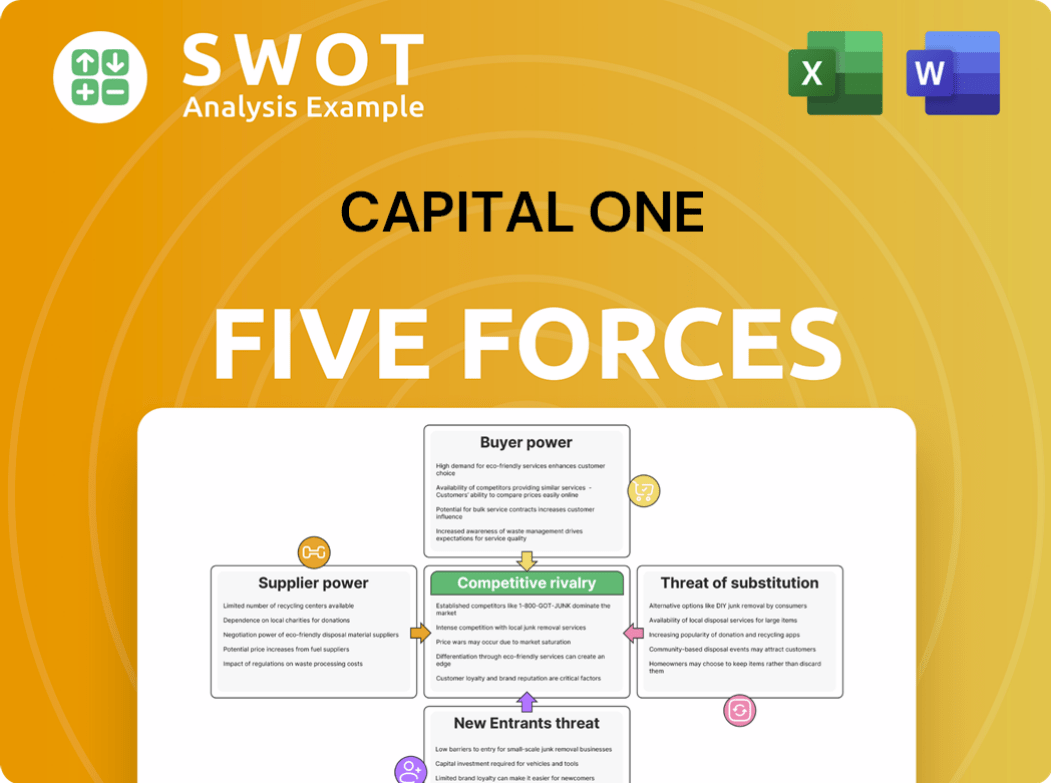Capital One Bundle
Can Capital One's Bold Moves Redefine the Future of Finance?
Capital One's recent acquisition of Discover Financial Services for $35.3 billion in February 2024 signals a monumental shift in the financial services industry. This strategic move aims to propel Capital One to the forefront of the U.S. credit card market, solidifying its position as a financial powerhouse. But what does this mean for its future, and how will it navigate the evolving Capital One SWOT Analysis landscape?

This in-depth analysis explores Capital One's ambitious growth strategy, examining its expansion plans and innovative initiatives within the banking sector. We'll delve into the company's future prospects, considering its market share analysis, competitive landscape, and how it plans to leverage digital transformation to stay ahead. Understanding Capital One's strategic initiatives is crucial for anyone looking to understand the future of the financial services industry and the potential for Capital One investment opportunities.
How Is Capital One Expanding Its Reach?
The core of the Capital One growth strategy revolves around its expansion initiatives, primarily fueled by the acquisition of Discover Financial Services. This strategic move is set to reshape the competitive landscape of the financial services industry. The acquisition, finalized on May 18, 2025, is a pivotal moment for the company.
This acquisition is projected to significantly boost Capital One's market position. The company is poised to become the largest credit card issuer in the U.S. by balance owed. This strategic move is expected to increase its overall market share to approximately 22%, solidifying its dominance in the banking sector trends.
Capital One's future prospects are heavily influenced by this expansion. The acquisition of Discover not only increases its market share but also provides access to Discover's payment network. This access gives Capital One a competitive edge over other issuers that rely on Visa and Mastercard.
This landmark acquisition, completed on May 18, 2025, is central to Capital One's expansion plans. It is expected to make Capital One the largest credit card issuer in the U.S. by balance owed. This strategic move strengthens the company's position in the financial services industry.
The acquisition is set to increase Capital One's overall market share to around 22%. This increase provides a significant competitive advantage. It also gives Capital One access to Discover's payment network.
Capital One plans to integrate Discover's global debit partnerships, such as UnionPay and RuPay. This integration aims to create a more unified international payment system. It will help to expand Capital One's global reach.
Capital One has committed to a five-year Community Benefits Plan following the acquisition. This plan involves mobilizing over $265 billion in lending, investment, and services. The goal is to advance economic opportunity and financial well-being across America.
Beyond the Discover acquisition, Capital One continues to focus on expanding its domestic card and auto businesses. The company is strategically positioning itself for long-term growth.
- The acquisition of Discover is expected to make Capital One the largest credit card issuer in the U.S.
- Capital One will integrate Discover's global debit partnerships.
- A five-year Community Benefits Plan will mobilize over $265 billion.
- The company's expansion initiatives are designed to diversify revenue streams.
Capital One SWOT Analysis
- Complete SWOT Breakdown
- Fully Customizable
- Editable in Excel & Word
- Professional Formatting
- Investor-Ready Format

How Does Capital One Invest in Innovation?
Capital One's growth strategy heavily relies on innovation and technology, positioning it at the forefront of the financial services industry. This approach enables the company to adapt swiftly to evolving market dynamics and customer expectations. Their commitment to digital transformation and AI integration underscores their dedication to enhancing customer experiences and operational efficiency, which are key factors in the company's future prospects.
The company's strategic investments in technology are designed to create a competitive advantage in the banking sector. By leveraging data and analytics, Capital One aims to personalize services and improve risk management. This focus on technological advancement is crucial for sustaining long-term growth and navigating the competitive landscape of the financial services industry.
Capital One's digital transformation is a cornerstone of its strategy, driving innovation and efficiency. The company's shift to the cloud by 2020 was a pivotal move, enabling rapid innovation and scalability. This cloud-native technology supports the development and deployment of AI models, which are critical for enhancing customer experiences and operational efficiency. This is a key aspect of their Marketing Strategy of Capital One.
Capital One became the first U.S. bank to fully transition to the cloud by 2020. This move enabled rapid innovation and scalability.
The company uses AI and ML to improve customer experiences and operational efficiency. Key applications include fraud detection and digital servicing.
A generative AI-powered agent servicing tool has achieved over 95% success in yielding relevant results for customer service representatives.
Capital One builds its own AI technologies, like its natural language processing (NLP) technology for its virtual assistant Eno, to deliver personalized services.
The company implements robust guardrails and collaborates with academia and regulatory organizations to advance ethical standards in AI.
Capital One was recognized with the 'Point of Sale Innovation Award' in the 9th annual FinTech Breakthrough Awards program in March 2025 for its Muse solution, a digital sales tool for car dealerships.
Capital One's innovation strategy is deeply rooted in AI and machine learning, which are essential for enhancing customer experiences and operational efficiency. The company utilizes AI in various areas, including anti-money laundering, cybersecurity, and fraud detection. For instance, the generative AI-powered agent servicing tool has demonstrated remarkable success, with over 95% of customer service representatives finding relevant results. Furthermore, Capital One develops its own proprietary AI technologies, such as the natural language processing (NLP) technology for its virtual assistant Eno, to deliver personalized services and improve efficiency. The company's commitment to responsible AI practices is fundamental to its design process, implementing robust guardrails and collaborating with academia and regulatory organizations to advance ethical standards. In March 2025, Capital One received the 'Point of Sale Innovation Award' for its Muse solution, a digital sales tool for car dealerships, highlighting its innovative approach.
Capital One leverages AI across multiple areas to improve operations and customer service.
- Anti-money laundering
- Cybersecurity
- Digital and call center servicing
- Fraud detection
- Multichannel marketing
- Product valuations
Capital One PESTLE Analysis
- Covers All 6 PESTLE Categories
- No Research Needed – Save Hours of Work
- Built by Experts, Trusted by Consultants
- Instant Download, Ready to Use
- 100% Editable, Fully Customizable

What Is Capital One’s Growth Forecast?
The financial outlook for Capital One reflects a strategy focused on sustained growth, supported by strategic initiatives and a strong capital position. The company's performance in 2024 and projections for 2025 highlight its resilience and adaptability in the financial services industry. An in-depth Competitors Landscape of Capital One analysis reveals the competitive dynamics influencing its financial trajectory.
For the full year 2024, analysts anticipated Capital One to report an Earnings Per Share (EPS) of $13.59, an increase of 8.6% from fiscal year 2023. Revenue for full year 2024 was US$27.4 billion, up 3.9% from FY 2023, though net income was down 3.1% to US$4.44 billion, resulting in an EPS of US$11.61.
Looking ahead to fiscal year 2025, analysts project Capital One's EPS to rise by 13% year-over-year to $15.35. This growth is expected to be driven by strategic initiatives and continued focus on its core business segments. The company's ability to navigate the evolving banking sector trends will be crucial in achieving these financial targets.
In Q1 2025, Capital One reported a net income of $1.4 billion, or $3.45 per diluted common share. Adjusted net income was $4.06 per diluted common share. Revenue was reported at $10 billion, down 2% from Q4 2024.
Net interest income reached $8,013 million in Q1 2025, a 7% year-over-year increase from Q1 2024. This growth reflects the company's effective management of its interest-earning assets and interest-bearing liabilities.
Capital One's liquidity position remains strong, with total liquidity reserves of $131.1 billion as of March 31, 2025, a 3% increase year-over-year. The company's robust capital position provides a solid foundation for future growth.
The common equity Tier 1 (CET1) capital ratio stood at a robust 13.6% at March 31, 2025, up from 13.5% at the end of 2024. The company anticipates maintaining its CET1 ratio around 12.5% for a few years post-acquisition of Discover.
Capital One's strategic initiatives for 2024 and beyond include a focus on digital transformation and customer acquisition strategies. The company is also exploring expansion plans and new product development to enhance its market share analysis and competitive landscape.
- Continued investment in technology and innovation in financial technology.
- Focus on risk management strategies to navigate economic conditions.
- Exploration of sustainability initiatives to align with evolving industry standards.
- Strategic focus on the future of credit cards and related services.
Capital One Business Model Canvas
- Complete 9-Block Business Model Canvas
- Effortlessly Communicate Your Business Strategy
- Investor-Ready BMC Format
- 100% Editable and Customizable
- Clear and Structured Layout

What Risks Could Slow Capital One’s Growth?
Analyzing the Capital One company analysis reveals several potential risks and obstacles that could influence its Capital One future prospects. The financial services industry is highly competitive, and Capital One growth strategy must navigate challenges from established players. Furthermore, economic downturns and regulatory changes pose significant hurdles that the company needs to address to maintain its trajectory.
Market competition remains a significant concern. Capital One faces intense rivalry from major credit card issuers. The acquisition of Discover, while expanding market share, also concentrates the company's focus on the credit card sector, potentially increasing its vulnerability to credit risks. Moreover, regulatory changes and economic fluctuations add further complexity to Capital One's operational environment.
The company's exposure to subprime borrowers is a critical risk factor. Around 31% of Capital One's domestic credit card portfolio and a similar portion of its auto loans are with subprime borrowers. These borrowers are more sensitive to economic downturns and higher interest rates, which can lead to increased credit losses. Rising tariffs could also negatively affect credit performance. Understanding the Revenue Streams & Business Model of Capital One is essential when assessing its risk profile.
The competitive landscape includes major players like JPMorgan Chase, American Express, and Citi. These institutions hold substantial market share, posing a constant challenge to Capital One's growth.
The Discover acquisition increases Capital One's focus on credit cards. While this expands market share, it also elevates the risks associated with this segment, particularly during economic downturns.
A significant portion of Capital One's portfolio is with subprime borrowers. These borrowers are more susceptible to economic fluctuations and interest rate hikes, which could lead to higher credit losses.
The Capital One-Discover merger faced scrutiny from antitrust advocates and lawmakers. Regulatory changes can introduce operational challenges and impact strategic plans.
Economic downturns can lead to increased defaults among subprime borrowers, affecting Capital One's financial performance. The company's ability to manage credit risk during these periods is crucial.
Rapid advancements in financial technology (FinTech) and digital transformation can disrupt traditional banking models. Capital One must continuously innovate to remain competitive and adapt to changing consumer behavior.
Capital One employs a robust enterprise-wide risk management framework (RMF) covering strategic, compliance, operational, reputation, credit, market, and liquidity risks. This framework includes objective setting, risk assessment, control activities, communication, program monitoring, and organization and culture. Since 2014, the company has been leveraging cloud computing to centralize processes and rules for faster, uniform decisions.
Capital One must navigate evolving regulations, including those related to the Capital One-Discover merger. Compliance with these regulations is essential to avoid penalties and maintain operational integrity. The OCC's consolidation of its supervision functions may also introduce short-term operational adjustments.
Capital One Porter's Five Forces Analysis
- Covers All 5 Competitive Forces in Detail
- Structured for Consultants, Students, and Founders
- 100% Editable in Microsoft Word & Excel
- Instant Digital Download – Use Immediately
- Compatible with Mac & PC – Fully Unlocked

Related Blogs
- What are Mission Vision & Core Values of Capital One Company?
- What is Competitive Landscape of Capital One Company?
- How Does Capital One Company Work?
- What is Sales and Marketing Strategy of Capital One Company?
- What is Brief History of Capital One Company?
- Who Owns Capital One Company?
- What is Customer Demographics and Target Market of Capital One Company?
Disclaimer
All information, articles, and product details provided on this website are for general informational and educational purposes only. We do not claim any ownership over, nor do we intend to infringe upon, any trademarks, copyrights, logos, brand names, or other intellectual property mentioned or depicted on this site. Such intellectual property remains the property of its respective owners, and any references here are made solely for identification or informational purposes, without implying any affiliation, endorsement, or partnership.
We make no representations or warranties, express or implied, regarding the accuracy, completeness, or suitability of any content or products presented. Nothing on this website should be construed as legal, tax, investment, financial, medical, or other professional advice. In addition, no part of this site—including articles or product references—constitutes a solicitation, recommendation, endorsement, advertisement, or offer to buy or sell any securities, franchises, or other financial instruments, particularly in jurisdictions where such activity would be unlawful.
All content is of a general nature and may not address the specific circumstances of any individual or entity. It is not a substitute for professional advice or services. Any actions you take based on the information provided here are strictly at your own risk. You accept full responsibility for any decisions or outcomes arising from your use of this website and agree to release us from any liability in connection with your use of, or reliance upon, the content or products found herein.